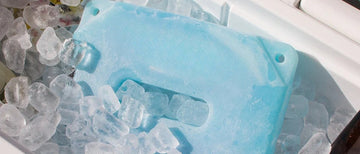
That burning, stinging feeling after too much sun can turn a fun day outdoors into a painful evening. When your skin is hot and tender, you’ll try almost anything for relief—and one of the first things people reach for is an ice pack. But do ice packs help sunburn, or could they actually make it worse?
Cooling the skin sounds like the right move, but there’s a right way and a wrong way to do it. In this guide, we’ll explain how ice packs affect sunburn, the safest ways to use them, and how it can help your skin heal faster and feel better.
Are Ice Packs Helpful for Treating Sunburn?
Putting something cold on a hot, painful sunburn feels like the obvious fix—and yes, it can help. Cold compresses or ice packs can reduce inflammation, cool your skin, and provide temporary relief from the stinging or burning sensation.
But here’s the thing: direct ice on sunburned skin is a bad idea. It can actually do more harm than good. When skin is sunburned, it's already damaged. Pressing ice right onto it can cause frostbite-like effects or worsen irritation.
So while ice packs can help, it’s all about how you use them—whether you’re applying an ice pack to your shoulder, face, neck, back, or arms.
The Safe Way to Use Ice Packs for Sunburn
If you’re reaching for an ice pack for sunburn, make sure you’re using it the right way to avoid further damage. While it might seem like a quick fix, improper use can actually worsen irritation.
-
Wrap the ice pack in a cloth: Never place it directly on your skin.
-
Apply for 10–15 minutes at a time: Give your skin a break in between sessions.
-
Don’t fall asleep with it on: It might feel good at first, but leaving it on too long can cause skin damage.
You can also use a cold, damp washcloth as a gentler option. It’s less intense than an ice pack but still helps reduce heat and swelling.
When to Use Ice Packs for Sunburn Relief

Using reusable ice packs after getting a sunburn can be effective, but timing and technique matter. Ice packs should be used within the first 24 hours after sun exposure for the best results.
After the Sunburn Appears
Once you notice the redness or feel the burn, using ice can help soothe the skin. It’s important to remember that while ice packs can offer temporary relief, they don’t heal the skin, so they should be combined with other treatments like moisturizing.
During the First 24 Hours
The first 24 hours are when the skin is most inflamed. Applying ice packs during this time can help manage pain and reduce swelling. After the first day, the effectiveness of ice tends to decrease, and the skin will begin its natural healing process.
How Ice Packs Work on Sunburns
When you’re dealing with a sunburn, your skin is inflamed, red, and often swollen. An ice pack is commonly used to treat inflammation and pain, and they can work wonders on sunburns as well. The coolness from the ice pack temporarily numbs the skin, providing immediate relief from the burning sensation.
Cooling Effect

Ice packs provide a quick cooling effect, which helps soothe the skin and temporarily reduces pain. The cold reduces the skin's temperature and can provide a calming feeling. This cooling effect can bring some comfort, especially when your skin feels hot to the touch.
Reducing Redness and Swelling
Sunburned skin is often red, irritated, and inflamed. Ice packs can help reduce the redness by cooling the skin and constricting blood vessels. This can help lower the swelling and make the burn feel less intense.
Decreasing Itchiness
If you’ve had a sunburn before, you know how itchy and uncomfortable the healing process can be. Ice can help numb the area, temporarily reducing the itch. While it doesn’t completely eliminate the urge to scratch, it can give your skin a break.
Final Thoughts
So, do ice packs help sunburn? Yes—if you use them carefully. They can offer temporary cooling and ease that burning feeling. But always wrap them up and limit how long they stay on your skin. Better yet, combine cool compresses with gentle moisturizers, hydration, and rest. Sunburn happens—even to the most sunscreen-conscious people. What matters is how you treat your skin afterward. Be kind to it, keep it cool, and let it recover at its own pace.
FAQs
Can I put ice directly on my sunburn?
No. Direct contact with ice can damage sensitive skin. Always wrap the ice in a cloth first.
How long should I use an ice pack on a sunburn?
Stick to 10–15 minutes at a time. Take breaks in between to prevent skin damage.
What’s better than an ice pack for sunburn?
A cool, damp cloth is gentler and still brings relief. Aloe vera gel and lightweight moisturizers also help.
Can ice packs stop sunburn from peeling?
They may reduce inflammation, but they won’t prevent peeling. Moisturizing and staying hydrated helps more.
Should I use ice packs on blistered sunburns?
If blisters form, it’s better to use cool water compresses and call your doctor. Ice could irritate the area more.




